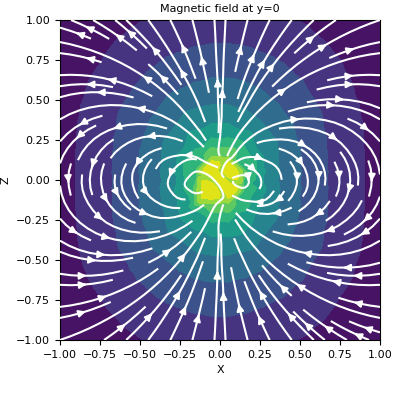geoana.em.static.MagneticDipoleWholeSpace.magnetic_field#
- MagneticDipoleWholeSpace.magnetic_field(xyz, coordinates='cartesian')#
Compute the magnetic field produced by a static magnetic dipole.
This method computes the magnetic field produced by the static magnetic dipole at the set of gridded xyz locations provided. Where \(\mathbf{m}\) is the dipole moment, \(\mathbf{r_0}\) is the dipole location and \(\mathbf{r}\) is the location at which we want to evaluate the magnetic field \(\mathbf{H}\):
\[\mathbf{H}(\mathbf{r}) = \frac{1}{4\pi} \Bigg [ \frac{3 \Delta \mathbf{r} \big ( \mathbf{m} \cdot \, \Delta \mathbf{r} \big ) }{| \Delta \mathbf{r} |^5} - \frac{\mathbf{m}}{| \Delta \mathbf{r} |^3} \Bigg ]\]where
\[\mathbf{\Delta r} = \mathbf{r} - \mathbf{r_0}\]For reference, see equation Griffiths (1999).
- Parameters:
- xyz(…, 3) numpy.ndarray xyz
gridded locations at which we calculate the magnetic field
- coordinates: str {‘cartesian’, ‘cylindrical’}
coordinate system that the location (xyz) are provided. The solution is also returned in this coordinate system. Default: “cartesian”
- Returns:
- (…, 3) numpy.ndarray
The magnetic field at each observation location in the coordinate system specified in units A/m.
Examples
Here, we define a z-oriented magnetic dipole and plot the magnetic field on the xz-plane that intercepts y=0.
>>> from geoana.em.static import MagneticDipoleWholeSpace >>> from geoana.utils import ndgrid >>> from geoana.plotting_utils import plot2Ddata >>> import numpy as np >>> import matplotlib.pyplot as plt
Let us begin by defining the magnetic dipole.
>>> location = np.r_[0., 0., 0.] >>> orientation = np.r_[0., 0., 1.] >>> moment = 1. >>> dipole_object = MagneticDipoleWholeSpace( >>> location=location, orientation=orientation, moment=moment >>> )
Now we create a set of gridded locations and compute the vector potential.
>>> xyz = ndgrid(np.linspace(-1, 1, 20), np.array([0]), np.linspace(-1, 1, 20)) >>> H = dipole_object.magnetic_field(xyz)
Finally, we plot the vector potential on the plane. Given the symmetry, there are only horizontal components.
>>> fig = plt.figure(figsize=(4, 4)) >>> ax = fig.add_axes([0.15, 0.15, 0.8, 0.8]) >>> plot2Ddata(xyz[:, 0::2], H[:, 0::2], ax=ax, vec=True, scale='log') >>> ax.set_xlabel('X') >>> ax.set_ylabel('Z') >>> ax.set_title('Magnetic field at y=0')
(
Source code,png,pdf)